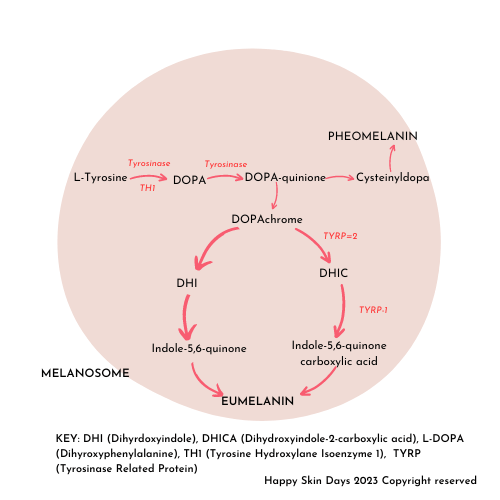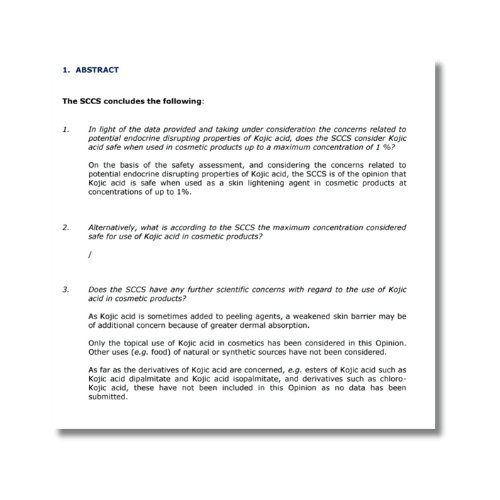History of kojic acid
Kojic Acid was first discovered in 1907 in Japan. Its a fungal metabolite that is associated with Aspergillus Oryzae, a mould that is used commonly in Japanese brewing.
This mould is used in the production of a number of foods, including miso (soybean paste),shoyu (soy sauce),and sake..
El-Kady et al (2014)
The story goes that factory workers handling soy etc had smooth and very fair hands and hence the research into kojic acid.
Chemical structure of kojic acid
INCI name is simply “kojic acid.” Its chemical structure is as follows:

Is kojic acid a skin lightener?
Yes, kojic acid is a skin-lightener. In fact, kojic acid (and hydroquinone, which is prohibited in the EU) are both used as the standard to measure the efficacy of other skin-lighteners.
Tell me more about kojic acid’s ability to lighten skin…
To answer this question I am going to take a slight detour and talk about melanogenesis and tyrosinase.
Melanogenesis is the synthesis of melanin (eumelanin and pheomelanin). Eumelanin has a photo-protective effect on our skin and is responsible for skin colour (see What gives our skin its colour?)

In our skin, Melanocytes contain melanosomes, which produce melanin. The building block of melanin is the very important amino acid, L-Tyrosine.
Tyrosinase is the enzyme that is critical to the formation of both Eumelanin and Pheomelanin. Copper is essential to the normal functioning of Tyrosinase.
E.g. Less Copper means less Tyrosinase activity which means less melanin is produced and skin becomes lighter.
As with any enzyme, there are many methods of inhibiting tyrosinase activity, and thereby reducing melanin. The inhibition of the tyrosinase is the SOP for most skin-lightening ingredients.
Where does kojic acid fit in the process of melanin formation?
In doing my research, it was not self-evident how kojic acid worked: some studies indicated it chelated Copper ions (at the site of the Tyrosinase enzyme) and others indicated other methods of tyrosinase inhibition.
Eventually, I am across this study from the scientific journal, Nature, which studied the effect of kojic acid on tyrosinase inhibition
The conclusion was that kojic acid is a mixed inhibition – chelating Copper ions was only one mechanism of tyrosinase inhibition.
Kojic Acid also had a different inhibitory mode on L-Tyrosine and L-Dopa.
The compound binds to the active site of L-Tyrosine (the amino acid) rendering further reactions not possible. So L-Tyrosine => Tyrosinase activity => Melanin formation
It also acts to inhibit the activity of DOPA preventing conversion to DOPAquinone.
Are there any long-term side effects of using kojic acid as a skin-lightener?
The Cosmeceutical Ingredient Review (CIR) indicates that this ingredient can be safely used at a concentration not higher than 1% due to its cytotoxicity.
A very limited study in Japan – by which I mean only 6 people, indicates that even after 10 years of use, there are are no adverse health effects of using 500mg of cream containing 1% kojic acid. Given the sample size, I would take this with a huge pinch of salt.
Source: Quasi-Drugs Containing Kojic Acid, Second Meeting of the Pharmaceutical Affairs and Food Sanitation Council in 2005. Ministry of Health, Labour and Welfare, 2 November 2005. Available online: http://www.mhlw.go.jp/shingi/2005/11/dl/s1102-8c.pdf (accessed on 16 July 2022). (In Japanese)
How is kojic acid treated by regulators?
Japanese regulation of kojic acid
In Japan, the regulatory regime for skincare products is essentially, cosmetics, drugs or pharmaceutical cosmetics (or quasi-drugs). Maeda et al write that pharmaceutical cosmetics are required to have at lease one of the following purposes:
- Cleansing
- Beautifying
- Increasing attractiveness
- Changing appearance and
- Maintaining healthy skin or hair
For an active to actually be classed as a pharmaceutical drug, means it has to be pass thresholds relating to efficacy or effectiveness, usage and dosage of the product. Maeda et al (2022) write that the threshold for skin-lightening active ingredients (such as kojic acid) was raised in 2019 to “prevents sun spots and freckles by suppressing melanin production.” That is a more specific threshold than the previous iteration of “prevents sun spots and freckles.”
EU regulation of kojic acid
The Scientific Committee on Consumer Safety* (self-explanatory function), had previously considered Kojic Acid (1182/08 and 1481/12 – Opinion on Kojic Acid). Off the back of these Opinions, the use of kojic acid was not regulated in the EU at all (or under the Cosmetic Regulation (EC) No, 1223/2009).
However, the SCCS, was asked to reassess Kojic Acid as “Kojic Acid has been reported to interfere with either iodine organification of iodine uptake by the thyroid, resulting in altered thyroid functions.“
This lead to the SCCS revisiting the date on kojic acid in the body and making the following opinion, which will hopefully be law soon:

* The Committee provides Opinions on health and safety risks of non-food consumer products (e.g. cosmetic products and their ingredients, toys, textiles, clothing) and services (e.g. tattooing, artificial sun tanning). (https://health.ec.europa.eu/scientific-committees_en)
Sources and uses
Ando, H.; Matsui, M.S.; Ichihashi, M. Quasi-Drugs Developed in Japan for the Prevention or Treatment of Hyperpigmentary Disorders. Int. J. Mol. Sci. 2010, 11, 2566-2575. https://doi.org/10.3390/ijms11062566
Choi, H., Kim, K., Han, J., Choi, H., Jin, S. H., Lee, E. K., Shin, D. W., Lee, T. R., Lee, A. Y., & Noh, M. (2012). Kojic acid-induced IL-6 production in human keratinocytes plays a role in its anti-melanogenic activity in skin. Journal of dermatological science, 66(3), 207–215. https://doi.org/10.1016/j.jdermsci.2012.03.002
Deri, B., Kanteev, M., Goldfeder, M. et al. The unravelling of the complex pattern of tyrosinase inhibition. Sci Rep 6, 34993 (2016). https://doi.org/10.1038/srep34993
The fungus which makes Japanese Food as Japanese food
El-Kady, Ismael A., Abdel Naser A. Zohri, and Shimaa R. Hamed. “Kojic acid production from agro-industrial by-products using fungi.” Biotechnology Research International 2014 (2014).
Chen JS, Wei C, Marshall MR. Inhibitionmechanism of kojic acid on polyphenol oxidase.Journal Agric Food Chem. 1991:39:1897-1901
Maeda, K. Timeline of the Development of Skin-Lightening Active Ingredients in Japan. Molecules 2022, 27, 4774. https://doi.org/10.3390/molecules27154774
Noh, Jin-Mi, et al. “Kojic acid–amino acid conjugates as tyrosinase inhibitors.” Bioorganic & medicinal chemistry letters 19.19 (2009): 5586-5589.
Phasha, V.; Senabe, J.; Ndzotoyi, P.; Okole, B.; Fouche, G.; Chuturgoon, A. Review on the Use of Kojic Acid—A Skin-Lightening Ingredient. Cosmetics 2022, 9, 64. https://doi.org/10.3390/cosmetics9030064
Scientific Committee on Consumer Safety (SCCS/1637/21) Opinion on kojic acid (Corrigendum)
https://www.cir-safety.org/sites/default/files/SM_Kojic%20Acid.pdf